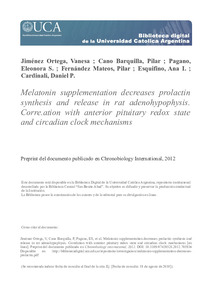Please use this identifier to cite or link to this item:
https://repositorio.uca.edu.ar/handle/123456789/1628| Título: | Melatonin supplementation decreases prolactin synthesis and release in rat adenohypophysis : correlation with anterior pituitary redox state and circadian clock mechanisms | Autor: | Jiménez Ortega, Vanesa Cano Barquilla, Pilar Pagano, Eleonora Samanta Fernández Mateos, Ana Esquifino, Ana I. Cardinali, Daniel Pedro |
Palabras clave: | MELATONINA; ESTACIONALIDAD; CORTICOSTERONA; TETOSTERONA; METALOTIONEINA | Fecha de publicación: | 2012 | Cita: | Jiménez Ortega, V., et al. Melatonin supplementation decreases prolactin synthesis and release in rat adenohypophysis : correlation with anterior pituitary redox state and circadian clock mechanisms [en línea]. Preprint del documento publicado en Chronobiology international, 2012. doi:10.3109/07420528.2012.705936. Disponible en: https://repositorio.uca.edu.ar/handle/123456789/1628 | Resumen: | Abstract: In the laboratory rat a number of physiological parameters display seasonal changes even under constant conditions of temperature, lighting and food availability. Since there is evidence that prolactin (PRL) is, among the endocrine signals, a major mediator of seasonal adaptations, we aimed to examine whether melatonin administration in drinking water resembling in length the exposure to a winter photoperiod could affect accordingly the 24-h pattern of PRL synthesis and release and some of their pituitary redox state- and circadian clock modulatory mechanisms. Melatonin (3 μg/mL drinking water) or vehicle was given for a month and rats were eutanized at 6 time intervals during a 24-h cycle. High concentrations of melatonin (more than 2000 pg/mL) were detected in melatonin-treated rats from the beginning of scotophase (at 21:00 h) to early photophase (at 09:00 h) as compared to a considerably narrower high melatonin phase observed in controls. In a cosinor analysis, melatonin-treated rats had significantly decreased mesor values of pituitary PRL gene expression and circulating PRL levels with acrophases at middle of scotophase as in the control group. Melatonin treatment disrupted the 24-h pattern in anterior pituitary gene expression of nitric oxide synthase (NOS)-1 and -2, heme oxygenase-1 and -2, glutathione peroxidase, glutathione reductase, Cu/Zn- and Mnsuperoxide dismutases and catalase by shifting their acrophases to early/middle scotophase or by amplifying the maxima found. Only the inhibitory effect of melatonin on pituitary NOS-2 gene expression correlated temporally with the inhibition of PRL production. Gene expression of metallothionein-1 and -3 showed maxima at early/middle photophase after melatonin treatment. 24-Hour pattern of pituitary lipid peroxidation did not vary after treatment. In vehicle-treated rats, Clock and Bmal1 expression peaked at mid scotophase while that of Per1 and Per2, and of Cry1 and Cry2, peaked at mid and late photophase, respectively. Treatment with melatonin decreased mean expression of Per1 and raised that of Per2, Cry1 and Cry2. Melatonin significantly phase-delayed expression of Per1, Per2 and Cry1. Melatonin also phasedelayed plasma corticosterone rhythm and increased the amplitude of plasma corticosterone and TSH rhythms. The results indicate that under a prolonged duration of a daily melatonin signal, rat pituitary PRL synthesis and release are depressed together with significant changes in the redox and circadian mechanisms controlling them | URI: | https://repositorio.uca.edu.ar/handle/123456789/1628 | ISSN: | 0742-0528 (impreso) 1525-6073 (online) |
Disciplina: | MEDICINA | DOI: | 10.3109/07420528.2012.705936 | Derechos: | Acceso Abierto | Fuente: | Preprint del documento publicado en Chronobiology international, 2012 |
| Appears in Collections: | Artículos |
Files in This Item:
| File | Description | Size | Format | |
|---|---|---|---|---|
| melatonin-supplementation-decreases-prolactin.pdf | 652,51 kB | Adobe PDF |  View/Open |
Page view(s)
163
checked on Apr 30, 2024
Download(s)
375
checked on Apr 30, 2024
Google ScholarTM
Check
Altmetric
Altmetric
This item is licensed under a Creative Commons License

